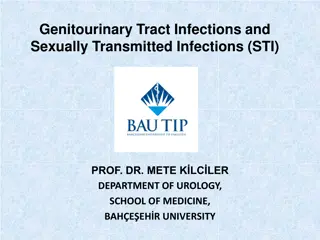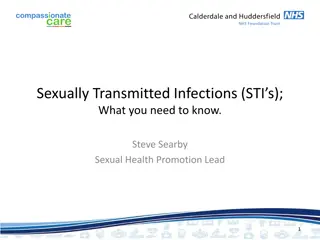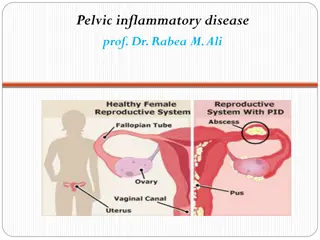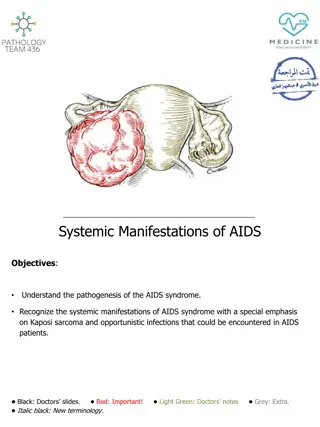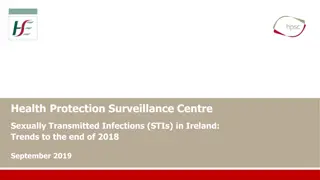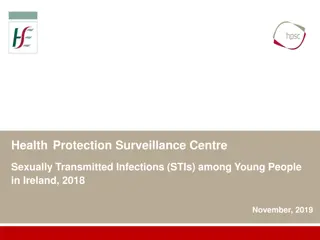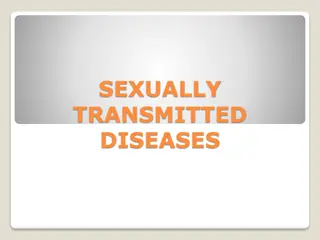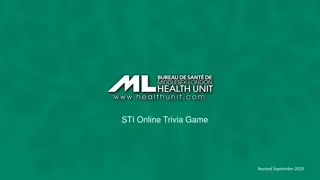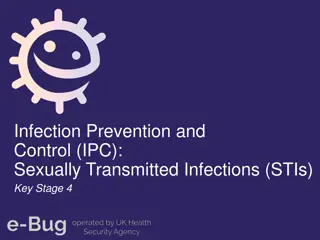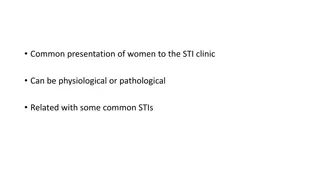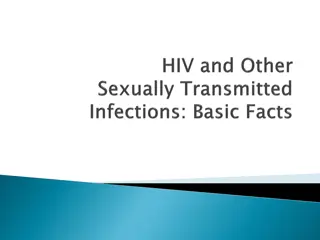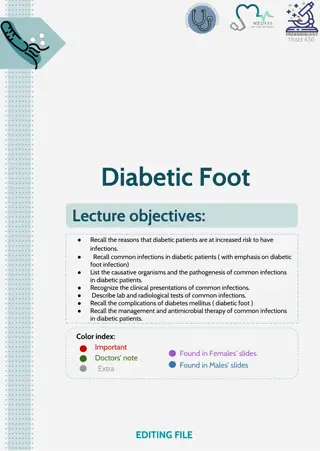Understanding Sexually Transmitted Infections (STIs) for Teens
Explore the comprehensive Teen Sexual Health Tool Kit 2.0 focusing on STIs, including an overview of STIs, common types like Chlamydia and HIV, symptoms, ways of transmission, and the importance of getting tested even without symptoms. Gain insights into categorizing STIs based on cure types and understand that most STIs may not exhibit visible symptoms. Enhance your awareness of STIs and protect your sexual health by staying informed and seeking testing when necessary.
Download Presentation

Please find below an Image/Link to download the presentation.
The content on the website is provided AS IS for your information and personal use only. It may not be sold, licensed, or shared on other websites without obtaining consent from the author. Download presentation by click this link. If you encounter any issues during the download, it is possible that the publisher has removed the file from their server.
E N D
Presentation Transcript
Teen Sexual Health Tool Kit 2.0 Sexually Transmitted Infections This publication was made possible by Grant Number TP1AH000081-01-01 from the Department of Health and Human Services, Office of Population Affairs; its contents are solely the responsibility of the authors and do not necessarily represent the official views of the Department of Health and Human Services.
STI What do the letters S.T.I. stand? Sexually Transmitted Infections You may hear the term STD used instead of STI. STD stands for Sexually Transmitted Disease. They mean the same thing.
What are the names of some STIs? Chlamydia Gonorrhea Syphilis Trichomoniasis Human Papillomavirus (HPV) Herpes HIV Hepatitis B Pubic Lice
Categorizing STIs Without Cure (Viral) With a Cure (Bacterial) Syphilis Gonorrhea Chlamydia HIV Herpes Hepatitis B HPV With a Cure (Parasitic) Trichomoniasis Pubic Lice
Symptoms of STIs Can include: Abnormal discharge and/or bleeding from the genitals of infected body part Pain, fever, swelling and tenderness Frequent urination, itching and burning in the infected area Warts, bumps, rashes and oozing sores which can be itchy, sore or painful The most common symptom is no symptoms at all!
No Symptoms? The majority of people who contract an STI will never experience symptoms or will experience symptoms so mild that they go unnoticed. You cannot tell just by looking at a person whether or not they have an STI. While external symptoms are possible, every person s body responds to STIs differently. This is important because even if a person is not having symptoms, STIs can still be causing damage to their reproductive system! The only way to know you have an STI is to get tested!
How can someone contract an STI? STIs are primarily spread through: Vaginal, anal and oral sex Other ways STIs can be transmitted: From mother to child during pregnancy or child birth Blood contact (through needles or syringes) Skin to skin contact with the infected body part. This does not include HIV!
A special note on HIV HIV stands for Human Immunodeficiency Virus. HIV is a virus that can be sexually transmitted. When a person becomes infected with HIV, their white blood cell count is reduced and their immune system is compromised. This means that the individual can become sick very easily. If left untreated, HIV can develop into AIDS which stands for Acquired Immune Deficiency Syndrome. HIV is the virus that causes AIDS. A person cannot have AIDS without having first contracted HIV.
A special note on HIV HIV can be transmitted through the following bodily fluids: - Blood - Semen - Vaginal fluids - Anal fluids - Breast Milk This means that not only can HIV be transmitted through vaginal, anal and oral sex, but the disease can also be transmitted through childbirth, breastfeeding or by sharing needles of any kind.
A special note on HIV When a person contracts HIV, their body begins to produce a specific type of antibody. HIV is not contained in saliva (meaning HIV cannot be transmitted through kissing!). However, HIV antibodies can be found in saliva. The oral rapid test is a simple mouth swab that tests for HIV antibodies. It can take up to three months after a person contracts HIV for their antibody count to be elevated enough to show up on a test. This means individuals participating in higher risk activities should be getting tested every three to six months.
Who can get an STI? Anyone can get an STI. They are infections/diseases that are spread primarily through sexual contact. Teens and young people are affected by STIs more than any other age group. According to the CDC, half of the 20 million new STI cases each year occur in youth ages 15 to 24.
How can a person avoid getting an STI? Not engaging in sexual activity that puts them at risk. This includes vaginal, anal and oral sex. The use of condoms and dental dams can help prevent the spread of STIs. This includes latex, polyurethane or polyisoprene external condoms, as well as nitrile internal condoms. Lambskin condoms are NOT effective in preventing the spread of STIs. Pre Exposure Prophylaxis (PrEP) is a pill that can be taken to help prevent the transmission of HIV*
In Review We know how STIs are transmitted. We know the signs and symptoms of an STI infection. We know some STIs don t have symptoms. We know how to avoid getting an STI. But why would we want to avoid getting an STI? Let s brainstorm some of the potential long-term physical and emotional complications of contracting an STI.
Potential Long-term Physical Complications Death (AIDS, syphilis, Hep B, and HPV related cancer if left untreated) Blindness (syphilis if left untreated) Paralysis (syphilis if left untreated) Heart disease (syphilis if left untreated) Brain damage (syphilis if left untreated) Cervical, vaginal, penile, anal or throat cancers (HPV) Infertility (gonorrhea and chlamydia) Ectopic pregnancy (gonorrhea and chlamydia) Pelvic inflammatory disease (gonorrhea and chlamydia) Chronic pelvic pain (gonorrhea and chlamydia) Liver damage (Hep B)
Potential Emotional Complications Sad Angry Confused Embarrassed Afraid Depressed Anyone engaging in sexual behaviors can be at risk for contracting an STI. It does not mean they are a dirty or a bad person.
Testing and Treatment Treatment requires the care of a doctor. Bacterial STI s can typically be detected in the urine or by taking a swab of the infected area. In some cases a blood test is used. Gonorrhea and chlamydia infections in the throat or rectum can only be tested and diagnosed with a throat or rectal swab. Treatment with antibiotics will cure a bacterial STI but any damage already done to the body cannot be reversed. Bacterial or parasitic STIs can be cured.
Testing and Treatment Viral STIs are not curable. There are medications to make the symptoms more manageable. Human Papilloma Virus (HPV) and Hepatitis B both have preventative vaccinations that can help the body develop immunities. You can talk to your physician, or visit your local health department, to learn more about these vaccinations. Free or reduce cost testing and treatment are available at your local health department.
A special note on Human Papillomavirus Human Papillomavirus is a group of more than 150 related viruses. HPV can be transmitted through skin to skin contact. For most people, HPV will clear up on its own within about two years. However, for some individuals, HPV can develop into cancer or genital warts. HPV can only be detected by testing cervical cells, this is done during a pap smear. There is not currently a test for those assigned male at birth.*
Important Things to Remember about STIs 1. STIs make you more vulnerable to HIV. Having an STI makes you 2 to 5 times more likely to contract HIV through sex. 2. You often can t tell a person has an STI just by looking at them. 3. People with vaginas or receptive partners are more likely to contract STIs than those with a penis/penetrating partner. 4. Many STIs are not curable, but they are ALWAYS preventable!
How can I prevent the spread of STIs? Getting tested, and having all of your partners get tested, will help reduce your risk of STIs including HIV. Getting tested at least once a year is recommended. If you know your status you can get treated early if needed. Condoms and/or dental dams can also help reduce the risk of STIs including HIV (along with PrEP for HIV). Not engaging in sexual activity is the only 100% effective way to prevent the spread of STIs.*
In closing You now know the basic information that will help you avoid getting an STI. Remember how STIs are transmitted, how to reduce your chance of contracting an STI, what can happen if you get infected and how to get tested. You can also avoid STIs by abstaining from behaviors that put you at risk.
For more information visit www.Centerstone.org/teen








